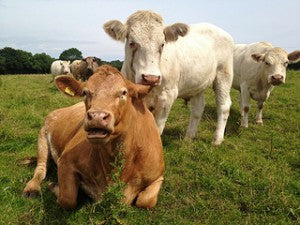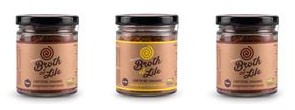
Written by Dave Asprey.
Not all meat is created equal. When people look at grass-fed meat, they assume it’s the same as grain-fed. One of the most common questions is, “Can I eat organic grain-fed meat instead?”
You can eat whatever you want, but grain-fed meat is not like grass-fed meat. It looks similar, tastes (somewhat) similar, and smells the same, but the truth is:
Grass-fed meat and grain-fed meat are two completely different foods.
Grass-fed meat isn’t a luxury item – it’s real meat. Factory meat has the wrong fatty acids, contains obesity-causing hormones, and usually has mycotoxins (very nasty biotoxins formed by mold in cattle food and meat processing). Grass-fed meat is in a league of its own.
Steers (castrated bulls) can’t make nutritious meat if they aren’t fed the proper ingredients. If a steer isn’t fed nutritious food, it won’t become nutritious food. There is no magical transformation from stale gummy bears (part of the feedlot diet) into vitamins, minerals, and healthy fats. Feeding cattle junk food turns them into junk food. Ruminant animals are meant to eat grass – not grains, stale bread, cereal, chicken feathers, or city garbage (I couldn’t make this up if I tried).
Besides health benefits, grass-fed meat is better for the economy, the environment, the farmers, and the animals. We won’t talk about the lack of hormones, antibiotics, or other fun chemicals agribusiness puts into your meat. I’m going to focus on what grass-fed meat does have – nutrition. There are many more studies we’ll be writing about in the future, but for now, we’re going to concentrate on the most recent and relevant.
The studies are in chronological order so you can see the evolution of research on this topic. Studies build on each other, and it’s important to see how the scientists interpreted data to build their conclusions.
To say one food is better than another, you have to prove it contains more nutrients and less toxins. This is the underlying principle of the Bulletproof Diet. The goal is to provide maximum nutrition with minimal damage.
Grass-fed meat fits this criteria perfectly. It contains more antioxidants, omega-3’s, CLA, TVA, trace minerals, and vitamins than any other food, including conventional meat.
As you’re about to learn, consuming grass-fed meat is one of the best ways to prevent disease, improve brain function, lose weight, and become Bulletproof.
Let’s begin.
The first study we’ll look at was published in 2006. It measured the fatty acid composition of grass-fed versus grain-fed meat. Before we dive into the research, here’s what you need to know.
1. Omega-3 fatty acids are an essential component of nerve tissue. They modify how the body responds to stress and control numerous other metabolic processes. Most people eat too many omega-6 fats and not enough omega-3.
2. CLA is a type of naturally occurring trans-fatty acid that improves brain function, causes weight loss, and reduces your risk of cancer.
What a steer eats dictates how much of these compounds are in the meat. This study compared how grain feeding effects this process.
Study #1: 2006
Researchers compared the fatty acid compositions of three kinds of feeding. Each group contained 18 Australian cattle. The first group was fed grains 80 days before slaughter, the second group was fed “by-product feedstuff” for 200 days, and the third group was grass-finished and grass-fed.
Group #1: Short Term Grain Feeding (80 days)
Group #2: Long Term Feedlot Rations* (150-200 days)
Group#3: Grass Feeding (Life time)
*Feedlot rations for australian beef are made of 50 percent barley and/or sorghum (a type of wheat) and some form of cottonseed/protein mix: A mixture of grains.
Results
The grass-fed cows had more omega-3’s and conjugated linoleic acid (CLA). Just 80 days of grain feeding was enough to destroy the omega-3 content of the beef. CLA content plummeted in the same amount of time. The longer the animals were fed grains, the lower the quality of the meat.
“There was a significantly higher level of total omega-3 (n-3) and long chain n-3 FA in grass-fed beef than the grain-fed groups regardless of cut types.”
The omega-3 quantity in grain-fed meat was so low, it didn’t qualify as a meaningful dietary source. Grass-fed meat has enough omega-3 to be considered a good source of n-3 fats. As Chris Masterjohn has shown us, the total amount of omega-3 we need is small if you have a good omega-6 to omega-3 ratio. Therefore, eating grass-fed meat along with some fatty fish may be enough to cover your omega-3 needs.
“Only grass-fed beef reached the target of more than 30mg of long chain n-3 FA/100 g muscle as recommended by Food Standard Australia and New Zealand for a food to be considered a source of omega-3 fatty acids.”
Grain feeding significantly reduces the omega-3 and CLA content of meat. The feedlot cattle had the lowest levels, the grain-fed cattle were in the middle, and the grass-fed cattle had the most. The longer an animal is fed grains, the lower the nutrient content of the meat.
Summary
- Grain-fed beef is much lower in omega-3’s and CLA
- The longer steers are fed grains, the lower the omega-3 and CLA content.
- Feedlot cattle have the lowest amount of omega-3‘s. Regular grain-fed cattle are slightly better.
- The last part of a cow’s life is the most critical in terms of fat quality.
Meat can be a good source of omega-3’s, if it’s grass-fed. Grain-fed meat has lower levels, so you’ll need to eat a lot of cold water ocean fish or take fish oil supplements to reach your daily omega-3 requirements. Grass-fed meat has more healthy fats than grain-fed meat.
This study only covered a few types of fats. The next study in this series shows how grass-fed beef has a broad spectrum of beneficial fats and other nutrients that are missing from grain-fed meat.
Fat can be a wonderful thing.
Fats can be the most nutrient rich part of your diet, or they can cause numerous diseases – depending on which fat we’re talking about. What an animal eats will change the kind of fat in its tissues. If an animal eats a suboptimal diet including grains and legumes, its fat loses much of its nutrient quality in surprisingly little time. The second study we cover examines fats present in grass-fed meat besides omega-3’s and CLA, along with various nutrients stored in the meat and the fat.
The study above showed grass-fed meat has more omega-3’s and CLA than grain-fed meat. Both of those fats are beneficial, but there’s more. The new study in this article compared a broad spectrum of nutrients in grass-fed and grain-fed beef. It measured carotenoids, the total amount of fat, and the types of fat including:
- Omega-3
- Omega-6
- Cholesterol (this isn’t a fat, but its still important)
- Total Saturated Fat
- Conjugated Linoleic Acid (CLA)
- Trans-Vaccenic Acid (TVA)*
*Trans-vaccenic acid is metabolized into conjugated linoleic acid, and performs similar functions. It can speed fat loss, fight cancer, and improve brain function. It is technically a naturally occurring “trans-fat” but it does not cause the same the negative health problems that margarine or hydrogenated fats do.
Study #2: Conventional vs. Grass-fed
“Effects of conventional and grass-feeding systems on the nutrient composition of beef.”
In 2008, meat samples were collected from around the country at three different times. Grass-fed meat was taken from 13 states, and grain-fed meat was collected from Ohio, Texas, and South Dakota. The nutrient content of the grass-fed meat was analyzed and compared to the grain-fed meat.
Results
The grass-fed meat had higher levels of carotenoids, making the fat appear yellow. Generally, the more carotenoids in a substance, the more nutrients it contains. Yellow fat (like grass-fed butter) is a sign of high nutrient density. One of the things you’ll notice when cooking grass-fed meat is the yellowish colour of the fat.
More carotenoids = more antioxidants+nutrients (and more flavour too).
“…grass-fed beef had fat that was more yellow in color than control beef.”
Grass-fed meat had slightly less total fat, but both types of meat were considered lean. Neither one of them was more than 4.3 percent fat for the cuts studied.
The real difference was the type of fat in each meat. Grass-fed meat was higher in saturated fat (that’s a good thing, but for you fat-phobic people, there are other studies that show grass-fed meat has less saturated fat), omega-3’s, CLA, and trans-vaccenic acid (similar to CLA). Both grain-fed and grass-fed animals had about the same amount of omega-6, total polyunsaturated fat, and cholesterol.
Grass-fed meat had the same amount of omega-6 fatty acids, and far more omega-3‘s. This means grass-fed meat has a better ratio of omega-6 to omega-3 fatty acids. The higher levels of saturated fat are a bonus. You want to avoid an overabundance of polyunsaturated fat.
“…grass-fed beef had… a greater content of SFA (saturated fats), n-3 fatty acids, CLA, and trans-vaccenic acid than did the control samples. Concentrations of PUFA, trans fatty acids, n-6 fatty acids, and cholesterol did not differ between grass-fed and control ground beef.”
Summary
Grass-fed meat was higher in…
- Carotenoids and trace nutrients.
- Saturated fat.
- CLA and TVA (super healthy fats)
- Omega-3’s.
Grass-fed and grain-fed meat had the same amount of omega-6 fats, cholesterol, and total polyunsaturated fats.
One of the most important health markers is your omega-6 to omega-3 fatty acid ratio. A commonly cited healthy ratio is 2:1 but the Bulletproof recommendation is to keep it below 1:1 and to make sure the omega-6 you eat is mostly uncooked. Most Americans have a ratio of 20:1 to 30:1. Along with other dietary measures, consuming grass-fed meat will help improve this ratio. Just like in the 2006 study cited above, grass-fed meat had more omega-3’s, CLA, and TVA. Grass-fed meat has more antioxidants, and a broader spectrum of healthy fats. The higher antioxidant content in grass-fed meat will also protect the omega-3’s and omega-6’s from oxidizing.
When it comes to meat, grass-fed and grain-fed don’t even compare. Go grass-fed, every time.




